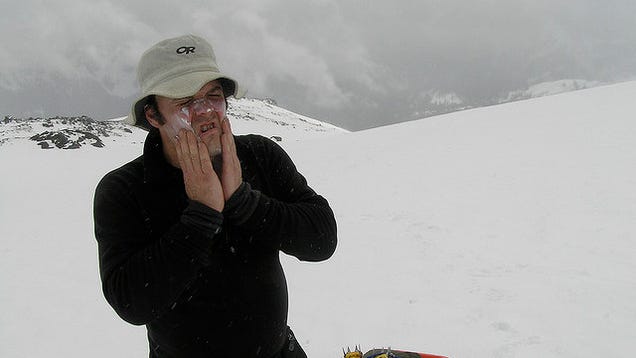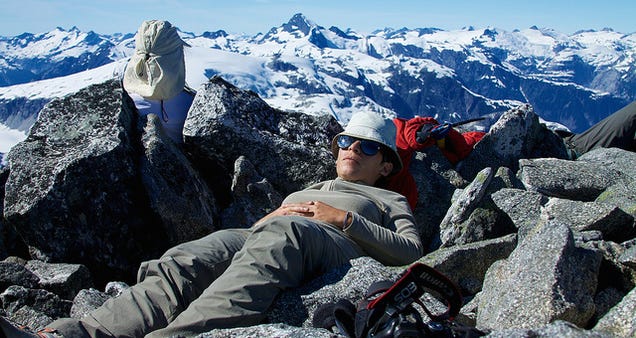How to Adjust to Higher Altitudes
With summer getting into full swing, it’s time to venture up to mountains and other higher elevations for vacations of all sorts. But the higher you get, the more your body hates it. Here’s what to expect before you hit those higher altitudes.
Adjusting to high altitudes (around 5000 feet above sea level and up) is all about acclimatization, but it takes your body days (or even weeks) to fully get used to being at a higher elevation. When you’re not used to it, you can get altitude sickness, which feels a lot like a hangover. Altitude sickness is serious business and the only treatment is going to a lower altitude, but if you have mild symptoms then you can deal with it safely. So, with that in mind, here’s how to enjoy yourself at higher altitudes without waiting the weeks for your body to actually adjust.
Drink More Water

You tend to lose water and sodium as your body acclimatizes to altitude, and this leads to dehydration. This is especially the case if you exercise, but chances are you’ll be dehydrated regardless of what you’re doing because the air is dryer and cooler.
So, drink a lot of water. There’s no hard and fast rule about how much water you need, but drink more than you would normally at home. Likewise, as the BBC points out, if you’re used to a temperate climate, your skin will feel dryer too:
If you’re a typical Brit used to a temperate climate, your skin may take a dive at high altitudes too. I swear I age about ten years in the mountains so I advise lathering on the thickest cream you can find to stop your face and hands turning into crepe.
If you can, it’s also not a bad idea to run a humidifier when you’re inside as well. That should help you better deal with the dry air. Basically, you want to get water into you any way you can.
Moderate Your Physical Activity

This one’s a bit tricky, because chances are when you get to a higher altitude, you’re going to struggle to do any kind of physical activity, so moderating it shouldn’t be a problem. Still, it’s worth noting that if you’re hoping to fly into the likes of Colorado, Tibet, Peru, or wherever else and get to hiking those mountains on the first day, it’s probably not going to work.
Since there’s less oxygen the higher you go, the heart works harder and you breathe faster. This means your heart rate gets up quickly, and you subsequently wear out quicker. Basically, if you run a mile at sea level you need a certain amount of oxygen. You need the same amount at a higher altitude, but it’s not there.
Regardless of how much exercise you do at home, you need to moderate your physical activity. Don’t try too hard for the first few days you’re at the higher altitude. For example, Runner’s World suggests you run about 25 to 50 percent less than you usually would for the first few days. That should go the same for any exercise.
Wear Sunscreen

It goes without saying that the higher the elevation, the closer you are to the sun. That means you’re going to need more sunscreen. Speaking with Reuters, Dr. Darrell Rigel describes it like so:
“You have to be extra careful at protecting yourself at high altitudes,” Rigel told Reuters Health. “People don’t realize how much additional sun you get at higher altitudes. It’s anywhere from an 8 percent to a 10 percent increase for every thousand feet of elevation. In the summertime, you can get anywhere from 40 percent to 50 percent greater sun intensity than at sea level.”
As we’ve pointed out before, sunscreen is important, and that’s definitely so a higher elevations. If you can, it’s also a good idea to wear a hat and cover up any way you can as well.
Get a Good Night’s Sleep

Getting a good night of sleep is always a good idea, but it’s tough when you’re at a higher altitude. You might not sleep as well for a variety of reasons, and that means you’ll be a little out of it. The U.S. Army Medical Department describes the problem like so:
Altitude exposure may have significant effects on sleep. The most prominent effects are frequent periods of apnea (a temporary pause in breathing) and fragmented sleep. Reports of “not being able to sleep” and “being awake half the night” are common and may also contribute to mood changes and daytime drowsiness. These effects have been reported at elevations as low as 1,524m and are very common at higher altitudes.
So, for the time you’re at a higher altitude, you might try some common suggestions for dealing with sleep apnea, including sleeping on your side or using a saline nasal spray to help keep your nasal passages open. WebMD suggests another way to correct for this is to, “climb high, sleep low:”
Sleep at an altitude that is lower than the altitude you were at during the day. For example, if you ski at 9500 ft (2896 m) during the day, sleep the night before and the night after at 8000 ft (2438 m). “Climb high, sleep low” is standard practice for those who spend time at high altitudes.
Likewise, as terrible as it sounds, you might just need to plan on getting a few nights of bad sleep before you acclimate, so plan accordingly.
Watch Your Alcohol Intake

There’s an old myth that you get drunk quicker at higher altitudes because the oxygen levels are lower, but it doesn’t really work like that. As we’ve pointed out before, alcohol tends to get you drunk at a consistent rate regardless of where you are.
However, as Gizmodo points out, altitude sickness might make you feel a lot worse when you drink:
So, while the altitude isn’t actually causing your BAC to go any higher, you may feel more drunk and sick because you are getting hit by two separate things at once. Dizzy + dizzy = more dizzy. Because there is no way to predict who will and won’t be affected by altitude sickness, this helps explain why drinking at high elevation is fine for some and horrible for others.
As we pointed out at the start, keeping yourself hydrated is rule number one for enjoying yourself at a higher altitude, and alcohol is a dehydrating diuretic. So, it’s best to give yourself a couple days to acclimate before you drink alcohol. Or at the very least, drink even more water to try and counteract the effects of alcohol.
Photos by Kevin Necessary, Jenni-o, Ryan Smith, Laurel F, McKay Savage, kaelin
Author: Thorin Klosowski
Original post from Lifehacker.com
“Your attitude towards failure determines your altitude after failure.”
~ John C. Maxwell







